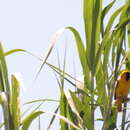Biology
provided by Arkive
The Kilombero weaver's small and patchy distribution is dictated by a number of biological factors, including a close physical association with reeds, as during flooding this is the only emergent vegetation on which it can feed. It cannot successfully inhabit areas near trees, due to these wooded areas being the home to a competitor, the golden weaver Ploceus subaureus (3). As well as the flowering and fruiting heads of reeds, the Kilombero weaver has also been observed feeding on human refuse, such as cooking waste, and can often be found around artificial habitats; perched on wooden huts, pecking at smoked fish or scavenging waste from behind shops (3). It is thought to breed during the wet season, probably between January and April, which may be due to the availability of high quality food from reed heads at this time of the year (3). Kilombero weavers nest in colonies of up to 30 pairs, on reed stems frequently overhanging water, and lay clutches of one to two eggs (4). In the dry season they have been seen in flocks, foraging on the ground (3).
Conservation
provided by Arkive
The Kilombero Valley Floodplain is a Ramsar site. The Ramsar Convention on Wetlands is an international treaty for the conservation and sustainable utilization of wetlands, which aims to stem the progressive encroachment on and loss of wetlands, recognizing their fundamental ecological, economic, cultural, scientific, and recreational value (5). Kilombero is also a National Game Controlled Area. However, this restricts only the hunting of large animals and does not protect the habitat (4). There are no specific conservation measures in place at present for the Kilombero weaver, but further research and monitoring of this bird has been recommended, to assess the effects of potential threats on this vulnerable species (4).
Description
provided by Arkive
Very little is known about the Kilombero weaver, a bird which occurs in only one valley in Tanzania, and was not discovered until 1986 (3). Belonging to a family of birds that are called weavers due to their elaborately woven nests, its plumage is yellow and brown, with particularly bright yellow on the underparts. The wings are also yellow, but barred brown. Males have a blackish face mask, edged with dark chestnut, which tapers to a point on the upper breast. The female is a duller version of the male and lacks the black face mask. It has dark brown eyes, a black bill and brownish-flesh coloured legs. Its song is a rambling series of buzzing sounds, chips and squeaks, typical of weavers (2) (4).
Habitat
provided by Arkive
Occurs in riverside marshes and seasonally flooded grasslands, generally close to Phragmites mauritianus reeds, and away from trees (2) (4).
Range
provided by Arkive
Found only on the Kilombero River floodplain in south-central Tanzania. Within this range, its distribution is patchy (4).
Status
provided by Arkive
Classified as Vulnerable (VU) on the IUCN Red List 2006 (1).
Threats
provided by Arkive
Increased use of the Kilombero valley by humans for agriculture poses a threat to the weaver through habitat loss, burning, and an increase in pesticide and fertilizers (3) (4). A sugar company situated close to the area has the potential to greatly impact the surrounding habitat if production expands, which would reduce the amount of suitable habitat for the weaver. Changes in the flooding regime, such as those caused by a dam, could also drastically alter the habitat to which the weaver is adapted (3). The Kihansi River, a tributary of the Kilombero, was dammed to generate hydropower in the early 1990s, but the effects this may have had on the animals and plants of the floodplain have not yet been investigated (5).
Kilombero weaver
provided by wikipedia EN
- license
- cc-by-sa-3.0
- copyright
- Wikipedia authors and editors
Kilombero weaver: Brief Summary
provided by wikipedia EN
The Kilombero weaver (Ploceus burnieri) is a species of bird in the family Ploceidae. It is endemic to Tanzania.
Its natural habitat is swamps. It is threatened by habitat loss.
- license
- cc-by-sa-3.0
- copyright
- Wikipedia authors and editors

